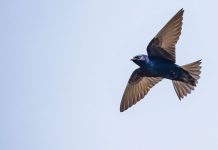
Building wood snowshoes the old-fashioned way requires patience and skill. The process takes time and a little know-how, but those who learn it say the effort is worthwhile. “Completing a pair is amazingly satisfying,” explains Chuck Nelson with Sarett Nature Center in Benton Harbor, where snowshoe building classes had been offered for many years.
“Once folks get the hang of it, they often build one pair to use and another to hang over the fireplace.”
Nelson, who taught the traditional art for more than four decades, said the process begins with selecting the right wood.
“Ash has been the preferred material, because it’s flexible and strong. Now days though, ash is growing scarce because of the emerald ash borer, so hackberry is becoming popular,” Nelson said.

Whatever wood is chosen, the strips must be boiled and softened and clamped into a jig. After drying in this position for about two weeks, they retain their bent shape. Next comes the lacing procedure, using material known as babiche.
“Historically, long strips of caribou hide or beaver intestines were woven together,” Nelson said. “Today, we use nylon treated with spar varnish, which looks a lot like rawhide, but is far less messy.”
Last comes the bindings. Where willow saplings were used years ago, repurposed inner tubes serve as harnesses now.
Alan Wernette, the interpreter at Ludington State Park, says “wooden snowshoes make perfect Christmas gifts.” He teaches snowshoe building and enjoys guiding snowshoe hikes on the park trails. His class is one of two offered at state parks this winter.
Wernette limits class enrollment to 10 students, so everyone gets the attention they need. Wood snowshoes, he said, offer a silent mode of travel through the winter woods.

“Once a student gets the stride down, they just float right along,” Wernette explains. “I love sharing that experience.”
 Early snowshoes were developed thousands of years ago, when an ancient innovator lashed bushes to his boots, according to Nelson. Since that first crude attempt, snowshoe designs have evolved. Several styles found favor in the Great Lakes region, with each offering advantages in varied terrain.
Early snowshoes were developed thousands of years ago, when an ancient innovator lashed bushes to his boots, according to Nelson. Since that first crude attempt, snowshoe designs have evolved. Several styles found favor in the Great Lakes region, with each offering advantages in varied terrain.
 Oval-shaped Bear Paws work well in heavy brush, where the Ojibwa design, with pointed fronts and backs, fare best in open country. Hurons are a hybrid of the other two styles, rounded in front and pointed in the back. Wernett said he prefers Ojibwas.
Oval-shaped Bear Paws work well in heavy brush, where the Ojibwa design, with pointed fronts and backs, fare best in open country. Hurons are a hybrid of the other two styles, rounded in front and pointed in the back. Wernett said he prefers Ojibwas.
“You literally float on top of the snow, and there’s less chance of stumbling,” he said.
— Jon Osborn, Michigan BLUE Magazine
Photography courtesy Dave Kenyon/ Michigan DNR
Want to build your own? Classes are offered at the following locations:
Hartwick Pines State Park
4216 Ranger Rd.
Grayling, MI 49738
989-348-7068
hartwickpines.com
Classes run December – March
Ludington State Park
8800 W. M-116
Ludington, MI 49431
231-843-2423
ludingtonstatepark.com
Classes run November – February







Facebook Comments